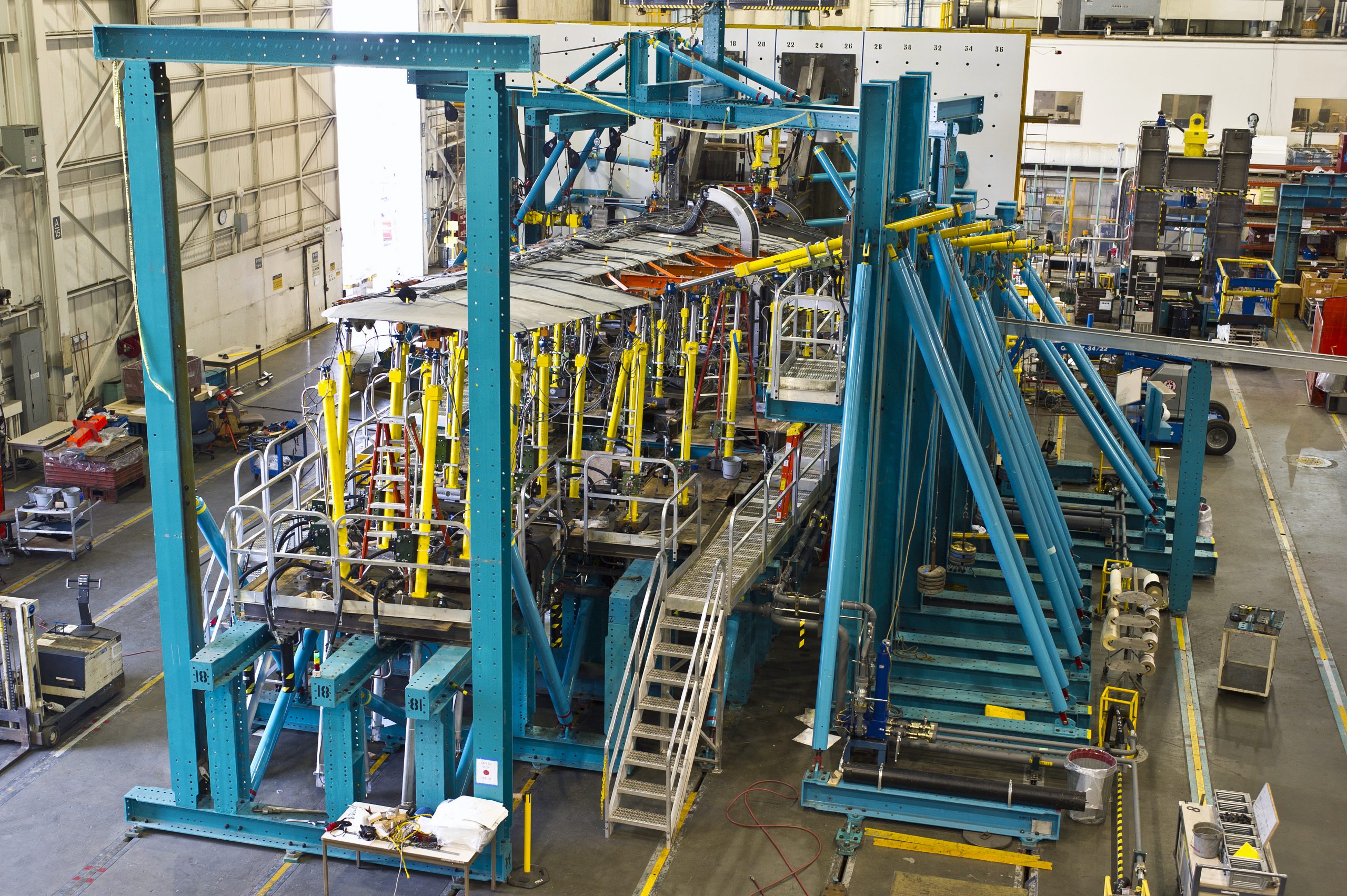Boeing conducts a fatigue test on the wing of a U.S. Air Force B-1 bomber in August 2012. The fatigue test, which was expected to take five years, is meant to validate the predicted life of the bomber fleet and to reveal potential areas of concern for which Boeing and the Air Force could develop maintenance and repair plans. Boeing photo.
The Air Force expects to conclude its structural fatigue test of a B-1B bomber next year, after a seven-year process and the amassing of almost 73 years of simulated flying time.
The fatigue test, underway since 2012, is being conducted on the carcass and wing of a retired B-1B harvested from the boneyard at Davis-Monthan Air Force Base, Ariz., and was expected to conclude this year. The plan is to stress the fuselage to a “certified service life” of 27,000 hours, while the wing is being stressed to 28,000 hours, an Air Force Materiel Command spokesman said. The B-1B, which was delivered between 1985 and 1988, was originally specified for a service life of about 8,000 hours, and has undergone service life extension programs since. At least one B-1B has racked up about 12,500 hours.
Boeing, which inherited the program from the original prime, Rockwell, is performing the test. It was initially expected to take five years, but has been interrupted several times to repair structural failures.
Structural fatigue tests employ calibrated weights, pulleys, pressure bars, and other physical means to simulate the stress of repeated takeoffs, landings, and typical mission G-loads on an aircraft. The tests continue around-the-clock, so that many years of stress can be applied for each year of testing. When the aircraft breaks under pressure, the test is stopped, the fault analyzed, and a fix applied as if the aircraft was an operational example, and the test resumes.
The AFMC spokesman said the Air Force is “evaluating fatigue points in the wing (mid-spar, leading and trailing edge tabs, upper wing splice bolts, and fuel drain holes) and various issues on the fuselage (cracks in longerons, forward/intermediate fuselage skins, Xf38 rib, shear angles, and tension clips).”
The findings of the test, he said, are “driving a fleet safety analysis, which includes analyzing data and conducting research. Results are then applied to the fleet to determine which aircraft are at risk and when inspection and repairs should begin.”
The Air Force has said it “broke” the B-1B by operating it in a way it wasn’t designed to fly, and as a result has seen significant structural damage that may make it too expensive to fix many of the Lancers still serving.
“The story of the B-1 is that we designed an aircraft to fly low-altitude, high speed/supersonic,” with its swing-wings folded back, “to penetrate enemy defenses and take out targets,” former Chief of Staff Gen. David L. Goldfein, now retired, said in September 2019.
However, for “the last 18 years, we’ve flown it at medium-altitude, very slow, wings forward,” he said. “We flew the B-1 in the least optimal configuration for all these years, and the result of that is we put stresses on the aircraft that we did not anticipate. When it goes into depot, we’re seeing significant structural issues.”
AFMC boss Gen. Arnold W. Bunch Jr said at the time that the stress test already underway on the B-1 had been paused to make wing repairs. The “least optimal configuration” Goldfein spoke of was carrying heavy loads with wings at full extension, putting inordinate stress on the wing attach points and the swing-wing mechanisms.
The B-1B was also meant to serve as a strategic nuclear bomber, meaning that for most of its service life, it was meant to fly a modest 300 hours a year in practice flights and spend the rest of the time sitting nuclear alert. It was never intended for continuous combat use, and, under initial plans, would have retired circa 2010.
As a consequence, Goldfein proposed retiring 17 of the highest-time B-1Bs and using the savings to raise the readiness of the remaining fleet, as well as upgrade the B-52 with new engines and other improvements.
The Air Force now plans to fully retire the B-1B around 2032, handing off its mission to the stealthy and largely secret B-21 Raider bomber. However, Gen. Timothy M. Ray, head of Air Force Global Strike Command, said in September 2019 that if the B-1s can be made to last, they would make an excellent carrier for standoff weapons, such as the new hypersonic AGM-183 ARRW, and add capacity to USAF’s bomber fleet.

Correction | Air & Space Forces Magazine
A Nov. 17 article on B-1 fatigue testing was incorrect, as a result of information provided by the Air Force, and has been removed from the website.


